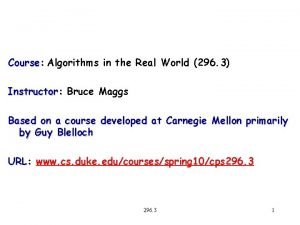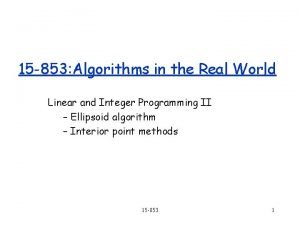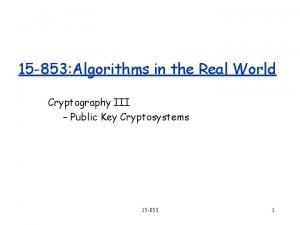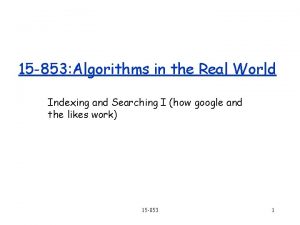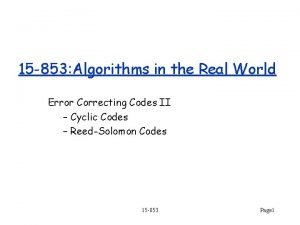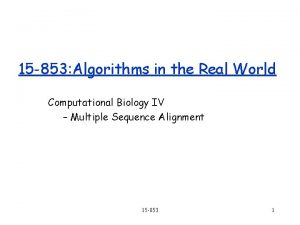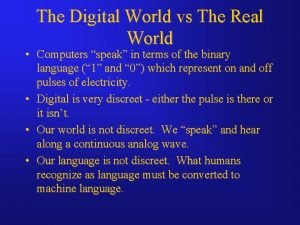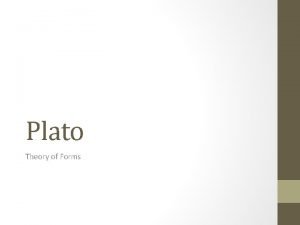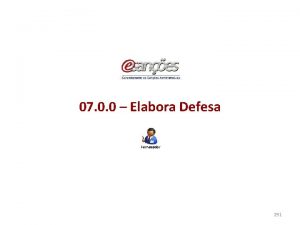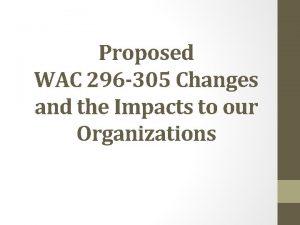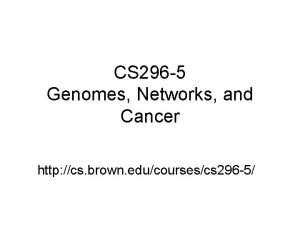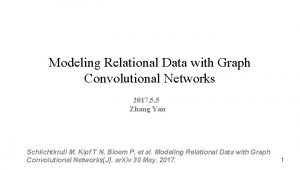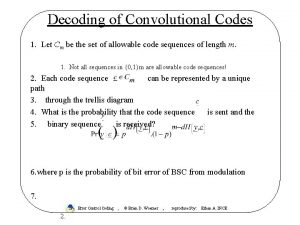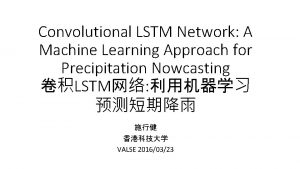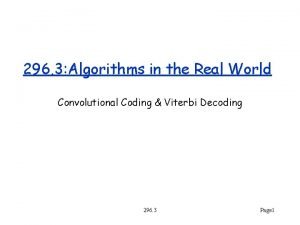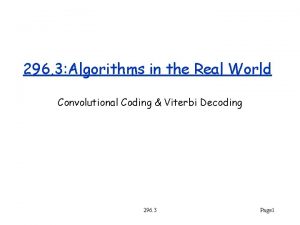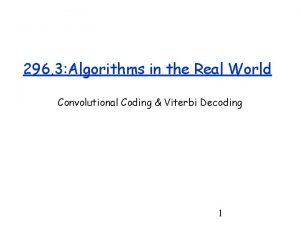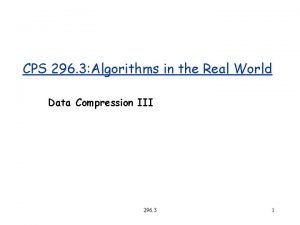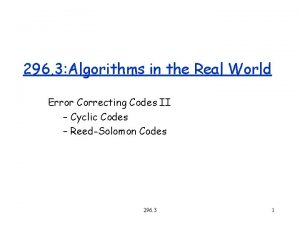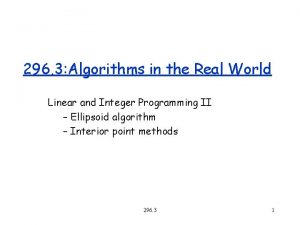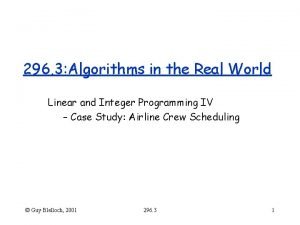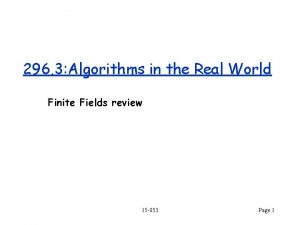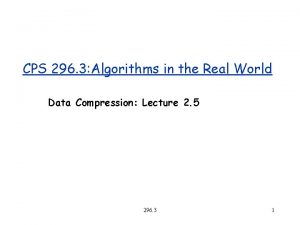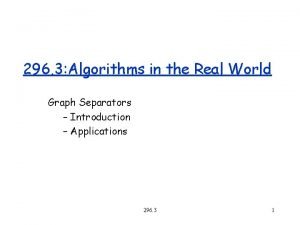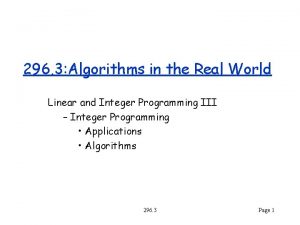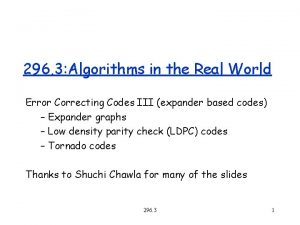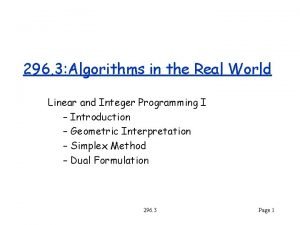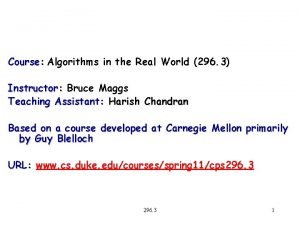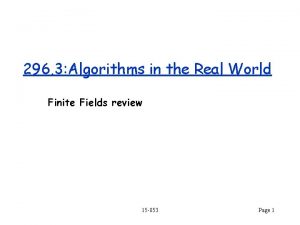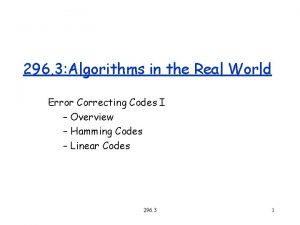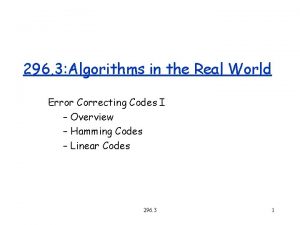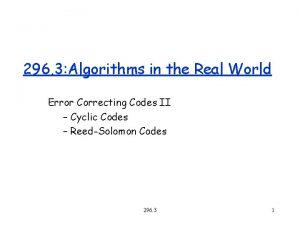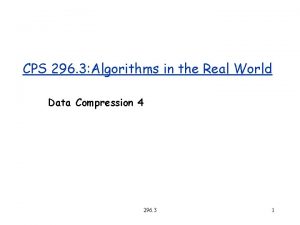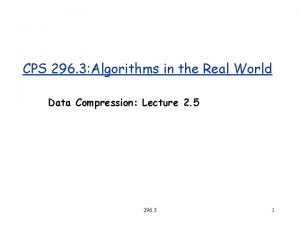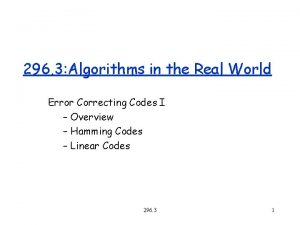296 3 Algorithms in the Real World Convolutional


























- Slides: 26

296. 3: Algorithms in the Real World Convolutional Coding & Viterbi Decoding 1

And now a word from my father… "First, computer software and hardware the most complex and rapidly developing intellectual creations of modem man. " -- p. iii, Internet and Computer Law, P. B. Maggs, J. T. Soma, and J. A. Sprowl, 2001 2

Today’s lecture is based on A Tutorial on Convolutional Coding with Viterbi Decoding Chip Fleming Spectrum Applications http: //home. netcom. com/~chip. f/viterbi/tutorial. html 3

Origin of Viterbi Decoding Andrew J. Viterbi, "Error Bounds for Convolutional Codes and an Asymptotically Optimum Decoding Algorithm, " IEEE Transactions on Information Theory, Volume IT-13, pp. 260 -269, April 1967. Viterbi is a founder of Qualcomm. 4

Terminology k n r m K number of message symbols (as before) number of codeword symbols (as before) rate = k/n number of encoding cycles an input symbol is stored number of input symbols used by encoder to compute each output symbol (decoding time exponentially dependent on K) 5

Convolution Encoder output upper input followed by lower input flip flop k = 15, n = 30, r = ½, K = 3, m = 2 (stores one bit) 6

Encoding Example Both flip flops set to 0 initially. Input: 010111001010001 Output: 00 11 10 00 01 11 11 10 00 10 11 00 11 Flush encoder by clocking m = 2 times with 0 inputs. 7

Viterbi Decoding Applications • decoding trellis-coded modulation in modems • most common FEC technique used in space communications (r = ½, K = 7) • usually implemented as serial concatenated block and convolutional coding – first Reed-Solomon, then convolutional • Turbo codes are a new parallel-concatenated convolutional coding technique 8

State Transition and Output Tables Next State, if Output Symbols, if Current State Input = 0: Input = 1: 00 00 10 01 10 11 00 01 01 Current State Input = 0: Input = 1: 00 00 11 01 11 00 10 10 01 11 01 10 10 11 11 State transition table 2 m rows Output table 9

State Transitions input symbol is 1 input symbol is 0 arcs labeled with output symbols 10

Trellis 11

Oh no! Errors in received bits! 12

Viterbi Decoding - Accumulated Error Metric Trying to find the input sequence who corresponding output matches the received output as closely as possible. (use Hamming distance in our example) 13

Accumulated Error Metric 14

Decoder Trellis 15

Decoder Trellis 16

Decoder Trellis 17

Final Decoder Trellis 18

Accumulated Error Metric over Time t= State 002 0 1 2 3 4 5 6 7 8 9 10 11 12 13 14 15 16 17 0 2 3 3 4 1 3 4 3 3 2 2 4 5 2 3 1 2 2 3 1 4 4 1 4 2 3 4 4 2 0 2 1 3 3 4 3 1 4 3 3 2 3 1 2 1 1 3 4 4 3 4 2 3 4 4 State 012 State 102 State 112 2 19 Last two inputs known to be zero.

Surviving Predecessor States t= 0 1 2 3 4 5 6 7 8 9 10 11 12 13 14 15 16 17 State 002 00 00 00 01 01 00 00 00 01 State 012 00 00 10 10 11 11 10 10 10 00 State 102 00 00 01 01 01 00 00 00 State 112 00 00 10 10 11 10 11 10 10 00 00 20

States Selected when Tracing Back t = 0 1 2 3 4 5 6 7 8 9 10 11 12 13 14 15 16 17 00 00 10 01 10 11 11 01 00 10 01 00 21

Coding Gain Transmission voltages (signal to noise ratio SNR 20 d. B). No errors. 22

Coding Gain Transmission voltages with Gaussian noise (SNR 6 d. B) bit error rate (BER) of about 0. 235% 23

Coding Gain convolutional coding with Viterbi decoding can achieve a BER of less than 1 x 10 -7 at the same SNR, 6 d. B r = ½, K = 3 Use 5 db less power to achieve 1 x 10 -7 BER than without coding Coding uses twice as much (3 d. B) bandwidth Coding gain: 5 d. B-3 d. B = 2 d. B less energy 24

References (from Fleming) Some Books about Forward Error Correction S. Lin and D. J. Costello, Error Control Coding. Englewood Cliffs, NJ: Prentice Hall, 1982. A. M. Michelson and A. H. Levesque, Error Control Techniques for Digital Communication. New York: John Wiley & Sons, 1985. W. W. Peterson and E. J. Weldon, Jr. , Error Correcting Codes, 2 nd ed. Cambridge, MA: The MIT Press, 1972. V. Pless, Introduction to the Theory of Error-Correcting Codes, 3 rd ed. New York: John Wiley & Sons, 1998. C. Schlegel and L. Perez, Trellis Coding. Piscataway, NJ: IEEE Press, 1997 S. B. Wicker, Error Control Systems for Digital Communication and Storage. Englewood Cliffs, NJ: Prentice Hall, 1995. 25

More References (from Fleming) Some Papers about Convolutional Coding with Viterbi Decoding For those interested in VLSI implementations of the Viterbi algorithm, I recommend the following paper and the papers to which it refers (and so on): Lin, Ming-Bo, "New Path History Management Circuits for Viterbi Decoders, " IEEE Transactions on Communications, vol. 48, October, 2000, pp. 1605 -1608. Other papers are: G. D. Forney, Jr. , "Convolutional Codes II: Maximum-Likelihood Decoding, " Information Control, vol. 25, June, 1974, pp. 222 -226. K. S. Gilhousen et. al. , "Coding Systems Study for High Data Rate Telemetry Links, " Final Contract Report, N 71 -27786, Contract No. NAS 2 -6024, Linkabit Corporation, La Jolla, CA, 1971. J. A. Heller and I. M. Jacobs, Viterbi Decoding for Satellite and Space Communications, " IEEE Transactions on Communication Technology, vol. COM-19, October, 1971, pp. 835848. K. J. Larsen, "Short Convolutional Codes with Maximal Free Distance for Rates 1/2, 1/3, and 1/4, " IEEE Transactions on Information Theory, vol. IT-19, May, 1973, pp. 371 -372. J. P. Odenwalder, "Optimum Decoding of Convolutional Codes, " Ph. D. Dissertation, Department of Systems Sciences, School of Engineering and Applied Sciences, University of California at Los Angeles, 1970. A. J. Viterbi, "Error Bounds for Convolutional Codes and an Asymptotically Optimum Decoding Algorithm, " IEEE Transactions on Information Theory , vol. IT-13, April, 1967, pp. 260 -269. 26
 Algorithms in the real world
Algorithms in the real world 15-853 algorithms in the real world
15-853 algorithms in the real world 15-853 algorithms in the real world
15-853 algorithms in the real world 15-853 algorithms in the real world
15-853 algorithms in the real world 15-853 algorithms in the real world
15-853 algorithms in the real world 15-853 algorithms in the real world
15-853 algorithms in the real world How polynomials are used in everyday life
How polynomials are used in everyday life Real world vs digital world
Real world vs digital world Allegory of the cave examples in real life
Allegory of the cave examples in real life Wac 296-155-305
Wac 296-155-305 Wac 296-800-160
Wac 296-800-160 Wac 296 305
Wac 296 305 Nnpj-296
Nnpj-296 Executari silite mihai bravu
Executari silite mihai bravu Wac 296 305
Wac 296 305 E-296
E-296 When placing solid web members for beams/columns
When placing solid web members for beams/columns Wac 296-307
Wac 296-307 Cs 296
Cs 296 Visualizing and understanding convolutional networks
Visualizing and understanding convolutional networks Modeling relational data with graph convolutional networks
Modeling relational data with graph convolutional networks Convolutional encoder
Convolutional encoder Convolutional neural networks for visual recognition
Convolutional neural networks for visual recognition Image style transfer using convolutional neural networks
Image style transfer using convolutional neural networks Convolutional codes solved examples
Convolutional codes solved examples What is stride in cnn
What is stride in cnn Convolutional lstm network
Convolutional lstm network
